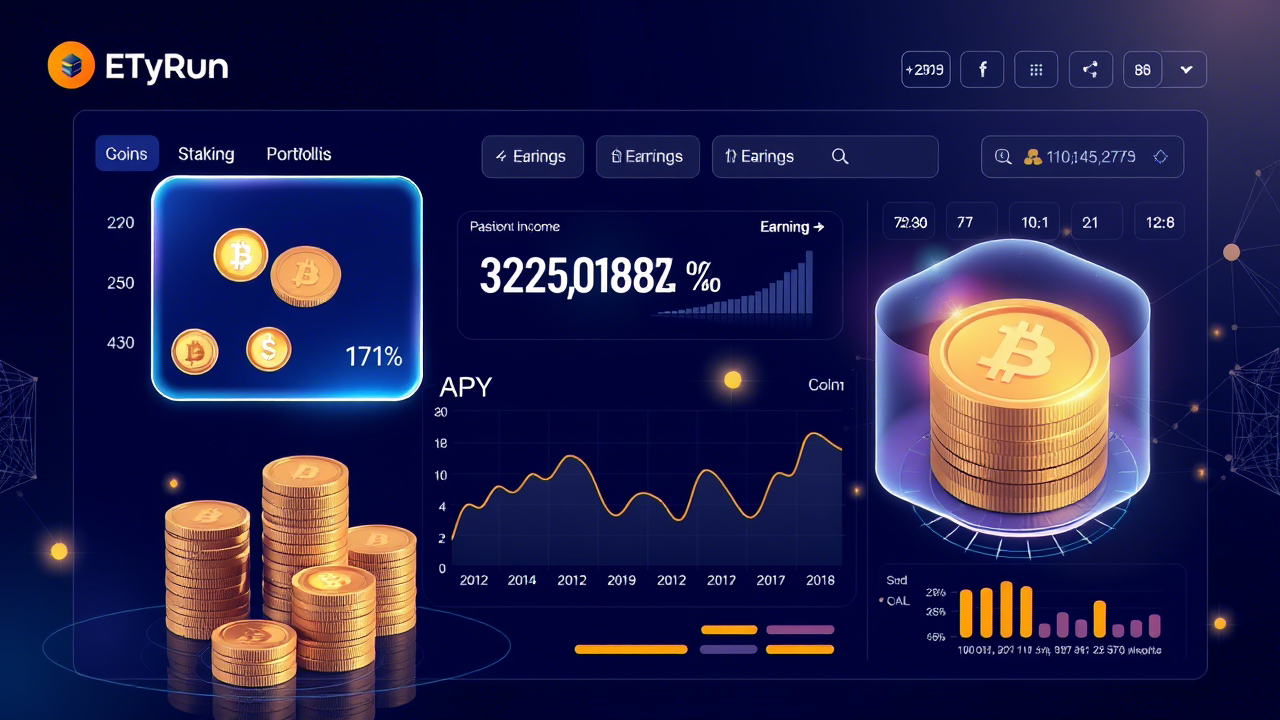The decentralized finance revolution has transformed how investors earn passive income from their digital assets. Crypto yield farming represents one of the most sophisticated earning strategies in the DeFi ecosystem, offering potentially higher returns than traditional investment methods. This comprehensive guide explores advanced yield farming strategies, platforms, and techniques that can help you maximize your crypto earnings while managing associated risks effectively.
Understanding crypto investment strategies is crucial before diving into yield farming, as these advanced techniques require a solid foundation in digital asset management.
Understanding Crypto Yield Farming Fundamentals
Crypto yield farming, also known as liquidity mining, involves providing liquidity to decentralized finance protocols in exchange for rewards. Unlike traditional banking where your money sits idle, yield farming puts your crypto assets to work across multiple DeFi platforms simultaneously. The process typically involves lending your cryptocurrencies to automated market makers (AMMs) or lending protocols, earning fees and governance tokens as compensation.
For beginners looking to understand the basics, our cryptocurrency for beginners guide provides essential foundational knowledge before exploring advanced yield farming strategies.
The concept emerged from the need to bootstrap liquidity for new DeFi protocols. Projects began incentivizing users to deposit their tokens by offering additional rewards beyond trading fees. This created a symbiotic relationship where protocols gained necessary liquidity while users earned enhanced returns on their holdings.
According to CoinMarketCap’s DeFi analysis, the total value locked (TVL) in DeFi protocols has grown exponentially, demonstrating the increasing adoption of yield farming strategies.
Modern yield farming strategies often involve complex multi-step processes called “farming compositions.” These might include providing liquidity to a decentralized exchange, earning LP tokens, staking those tokens for additional rewards, and potentially using the earned tokens in other yield farming opportunities. The compounding effect of these strategies can significantly amplify returns for sophisticated investors.
What Is Crypto Yield Farming and How Does It Work?
Yield farming crypto operates on the principle of maximizing returns through strategic asset deployment across various DeFi protocols. The process begins when you deposit your cryptocurrencies into liquidity pools, which are smart contracts containing pairs of tokens that facilitate trading on decentralized exchanges.
Understanding blockchain technology is essential for comprehending how these smart contracts function and the underlying mechanisms that make yield farming possible.
When you provide liquidity, you receive liquidity provider (LP) tokens representing your share of the pool. These LP tokens can often be staked in additional protocols to earn extra rewards, creating multiple income streams from a single initial deposit. The total yield comes from trading fees, governance token rewards, and sometimes bonus incentives from the protocols themselves.
The automated nature of yield farming means your assets continue generating returns 24/7 without active management. However, this also means you’re exposed to various risks including smart contract vulnerabilities, impermanent loss, and market volatility. Understanding these mechanics is crucial before deploying significant capital in yield farming strategies.
Advanced yield farmers often employ strategies like “yield farming aggregation,” where they use platforms that automatically move funds between different protocols to optimize returns. This approach requires less manual intervention while potentially achieving better risk-adjusted returns than manual farming strategies.
For those interested in exploring various crypto trading strategies, yield farming represents one of the most sophisticated approaches available in the digital asset space.
Liquidity Mining vs Traditional Crypto Yield Farming
Liquidity mining represents a specific subset of yield farming focused on providing liquidity to decentralized exchanges and automated market makers. While traditional crypto farming might involve simple staking or lending, liquidity mining requires you to deposit equal values of two different tokens into a trading pair pool.
The key difference lies in the risk-return profile. Traditional farming typically offers more predictable returns with lower risks, while liquidity mining can provide higher yields but exposes you to impermanent loss when token prices diverge significantly. Liquidity miners earn from multiple sources: trading fees from the pool, governance tokens from the protocol, and sometimes additional incentive rewards.
Liquidity mining strategies often involve more complex calculations and monitoring. You need to track the performance of both tokens in your pair, monitor pool utilization rates, and understand how changes in trading volume affect your earnings. This complexity requires more sophisticated tools and knowledge compared to simple staking strategies.
Many experienced yield farmers combine both approaches, using traditional farming for stable base returns and liquidity mining for enhanced yields on smaller portions of their portfolio. This diversification strategy helps balance risk while maximizing overall returns across different market conditions.
Similar to crypto staking strategies, liquidity mining offers another pathway to passive income, though with different risk profiles and potential returns.
Advanced DeFi Crypto Yield Farming Strategies
Advanced DeFi yield farming involves sophisticated strategies that go beyond basic liquidity provision. These strategies often involve multiple protocols, complex token swaps, and careful risk management to maximize returns while minimizing exposure to various DeFi risks.
Delta-neutral farming represents one of the most advanced strategies, where farmers maintain neutral exposure to price movements while earning yields. This might involve borrowing assets to provide liquidity while simultaneously holding offsetting positions, effectively eliminating price risk while capturing farming rewards.
Leveraged yield farming amplifies returns by borrowing additional capital to increase your farming position. Platforms like Alpha Homora and Leverage Protocol allow you to borrow against your LP tokens to provide additional liquidity, potentially doubling or tripling your farming rewards. However, this strategy significantly increases risk and requires careful monitoring of liquidation levels.
Cross-chain yield farming involves deploying assets across multiple blockchain networks to capture the highest yields available. This strategy requires understanding different blockchain ecosystems, managing bridge risks, and often involves higher gas fees but can provide access to emerging opportunities with exceptionally high yields.
For comprehensive information about cross-chain opportunities, DeFiLlama provides real-time data on yield farming opportunities across multiple blockchain networks.
Can You Make Money From Crypto Yield Farming?
Yes, crypto farming can be profitable, but success depends on multiple factors including market conditions, platform selection, strategy execution, and risk management. Historical data shows that successful yield farmers have achieved annual percentage yields (APYs) ranging from 10% to over 1000% during certain market conditions.
The profitability of crypto farming varies significantly based on the strategies employed. Conservative farming approaches focusing on established protocols like Uniswap or Compound typically offer more stable returns in the 5-20% APY range. More aggressive strategies involving newer protocols or leveraged positions can yield much higher returns but with correspondingly higher risks.
Understanding crypto market analysis is crucial for identifying profitable farming opportunities and timing your entries and exits effectively.
Transaction costs play a crucial role in farming profitability. During periods of high Ethereum gas fees, smaller farmers may find their profits significantly reduced by transaction costs. Many profitable farmers now use Layer 2 solutions or alternative blockchains with lower fees to maintain profitability even with smaller capital bases.
The key to profitable farming lies in understanding the relationship between risk and reward. Higher yields often come with higher risks, including smart contract vulnerabilities, impermanent loss, and potential token devaluations. Successful farmers develop strategies that balance these factors while maintaining diversification across multiple protocols and strategies.
Is Crypto Yield Farming Still Profitable in 2025?
Yield farming remains profitable in 2025, though the landscape has evolved significantly since the DeFi boom of 2020-2021. While the astronomical yields of early DeFi protocols have normalized, sustainable farming opportunities continue to emerge across various blockchain ecosystems.
The maturation of the DeFi market has led to more sophisticated farming strategies and better risk management tools. Modern yield farmers benefit from improved smart contract security, better auditing practices, and more sophisticated yield optimization platforms that automatically manage farming positions.
Current market conditions favor farmers who understand cross-chain opportunities and can navigate the evolving regulatory landscape. Layer 2 solutions and alternative blockchains have opened new farming venues with lower costs and innovative reward mechanisms, creating fresh opportunities for profitable farming strategies.
The integration of traditional finance concepts with DeFi has created hybrid opportunities that combine the best of both worlds. Real-world asset tokenization and institutional DeFi adoption have created new categories of yield farming opportunities that appeal to both retail and institutional investors.
For those considering crypto investment for beginners, understanding these evolving market dynamics is essential before deploying capital in yield farming strategies.
Best Crypto Yield Farming Platforms
Selecting the right yield farming platform is crucial for maximizing returns while minimizing risks. Established platforms like Uniswap V3, Compound, and Aave offer proven track records and strong security measures, making them excellent choices for conservative farming strategies.
When choosing platforms, consider using top crypto apps that provide secure access to multiple DeFi protocols and comprehensive portfolio tracking features.
Curve Finance specializes in stablecoin farming and offers some of the most efficient trading mechanisms for similar assets. Their concentrate liquidity model and gauge voting system provide unique opportunities for farmers to earn both trading fees and governance rewards while maintaining relatively low impermanent loss exposure.
Convex Finance has emerged as a major player in the Curve ecosystem, offering boosted rewards for Curve LP tokens. Their platform simplifies the complex process of earning maximum rewards from Curve positions while providing additional CRV and CVX token incentives.
Yearn Finance pioneered the concept of yield farming aggregation, automatically moving funds between different protocols to optimize returns. Their vault system simplifies yield farming for users who prefer automated management while still providing competitive returns across various strategies.
For detailed platform comparisons and security assessments, CoinGecko’s DeFi section provides comprehensive analysis of various yield farming platforms and their historical performance.
Crypto Yield Farming vs Staking: Key Differences
Understanding the differences between crypto farming and staking is essential for choosing the right earning strategy for your portfolio. Staking involves locking up tokens to support blockchain network operations, typically earning rewards in the same token you’re staking.
Crypto farming, particularly yield farming, involves providing liquidity or participating in more complex DeFi protocols. While staking rewards are generally more predictable, farming can offer higher yields but with additional risks like impermanent loss and smart contract vulnerabilities.
The liquidity requirements differ significantly between these strategies. Staking often requires lock-up periods where your tokens are inaccessible, while many farming strategies allow you to withdraw your funds at any time, though you may face impermanent loss when exiting liquidity positions.
Risk profiles also vary considerably. Staking primarily involves validator risk and potential slashing, while farming encompasses smart contract risks, impermanent loss, and exposure to multiple token price movements. Understanding these differences helps you allocate your portfolio appropriately between different earning strategies.
For comprehensive guidance on building a balanced crypto portfolio, explore our cryptocurrency investment strategies that cover both traditional and DeFi earning methods.
Highest APY Yield Farming Opportunities
High APY yield farming opportunities often emerge from new protocols seeking to bootstrap liquidity or established platforms launching new features. These opportunities typically offer rewards significantly above market rates but require careful evaluation of associated risks.
Newly launched protocols frequently offer extremely high APYs to attract initial users and liquidity. While these can be highly profitable, they also carry the highest risks due to unproven smart contracts, potential token value volatility, and possible protocol failures.
Established protocols sometimes offer boosted yields during specific events like liquidity mining campaigns or governance token distributions. These opportunities often provide better risk-adjusted returns as they combine higher yields with proven protocol security.
Cross-chain farming opportunities frequently offer elevated APYs as users are compensated for the additional complexity and risks involved in bridging assets between different blockchain networks. These strategies require understanding multiple blockchain ecosystems but can provide access to some of the highest sustainable yields available.
For current yield farming opportunities across different chains, DeFiPulse provides real-time data on total value locked and yield rates across major DeFi protocols.
Crypto Yield Farming Calculator and Tools
Effective yield farming requires sophisticated tools to track performance, calculate returns, and manage risks. Modern farming calculators consider multiple variables including token prices, pool fees, governance token rewards, and impermanent loss to provide accurate yield projections.
Popular tools like DeFiPulse, Zapper, and DeBank provide comprehensive portfolio tracking and yield calculation features. These platforms aggregate data from multiple protocols, making it easier to compare opportunities and track the performance of complex farming strategies.
Advanced farmers often use specialized tools like Revert Finance for detailed impermanent loss analysis and APY.vision for historical yield tracking. These tools help farmers understand the true profitability of their strategies after accounting for all costs and risks.
Many platforms now offer built-in calculators that estimate potential returns based on current market conditions. However, these tools should be used as starting points rather than definitive predictions, as DeFi markets can change rapidly and significantly impact actual returns.
Bitcoin Yield Farming Strategies
Bitcoin yield farming has evolved significantly with the development of wrapped Bitcoin (WBTC) and other Bitcoin-pegged tokens that can be used in DeFi protocols. These strategies allow Bitcoin holders to earn yields while maintaining exposure to Bitcoin price movements.
For those interested in Bitcoin-specific strategies, our guide on how to buy Bitcoin provides foundational knowledge before exploring advanced yield farming techniques.
The most common Bitcoin farming strategies involve using WBTC in liquidity pools paired with stablecoins or ETH. These strategies typically offer moderate yields with relatively low impermanent loss risk, making them attractive to Bitcoin holders seeking additional returns.
More advanced Bitcoin farming strategies involve using Bitcoin as collateral in lending protocols to borrow stablecoins, which are then deployed in higher-yielding farming opportunities. This approach can amplify returns but requires careful management of liquidation risks and interest rate costs.
The emergence of Bitcoin Layer 2 solutions and sidechains has created new farming opportunities specifically designed for Bitcoin holders. These platforms often offer native Bitcoin rewards while providing DeFi functionality that wasn’t previously available to Bitcoin users.
Ethereum and ETH Yield Farming
Ethereum yield farming represents the most mature and diverse sector of the DeFi ecosystem. ETH can be used in countless farming strategies, from simple liquidity provision to complex multi-protocol compositions that maximize returns across the entire Ethereum ecosystem.
ETH staking has become increasingly popular, especially with the transition to Proof of Stake. Liquid staking protocols like Lido and Rocket Pool allow users to earn staking rewards while maintaining liquidity through derivative tokens that can be used in additional farming strategies.
The combination of ETH staking rewards with DeFi farming creates unique opportunities for compounding returns. Farmers can stake their ETH, receive liquid staking tokens, and then use these tokens in farming strategies to earn additional yields on top of staking rewards.
Advanced ETH farming strategies often involve using ETH as collateral in lending protocols while simultaneously earning staking rewards. These strategies require careful risk management but can provide some of the highest sustainable yields available in the DeFi ecosystem.
Platform-Specific Farming Strategies
Different platforms offer unique farming opportunities that require specialized strategies. Understanding platform-specific features and incentive structures is crucial for maximizing returns and managing risks effectively.
Uniswap V3’s concentrated liquidity model allows farmers to provide liquidity within specific price ranges, potentially earning higher fees but requiring more active management. This approach works best for pairs with predictable trading ranges and requires regular position adjustments.
Compound’s lending markets offer straightforward farming opportunities with additional COMP token rewards. The platform’s governance token distribution creates opportunities for farmers to earn both lending interest and governance rewards while maintaining relatively low risk exposure.
Balancer’s multi-token pools and customizable fee structures create unique farming opportunities for sophisticated investors. The platform’s smart pool technology allows for automated rebalancing and custom investment strategies that can optimize returns across multiple assets.
Risk Management in Yield Farming
Effective risk management is essential for successful yield farming, as the DeFi space presents unique risks that don’t exist in traditional finance. Smart contract risk represents one of the most significant threats, as bugs or vulnerabilities in protocol code can result in complete loss of funds.
Impermanent loss risk affects all liquidity providers and requires careful consideration when selecting farming strategies. Understanding how different asset pairs behave under various market conditions helps farmers choose strategies that balance yield potential with acceptable impermanent loss risk.
Platform and protocol risks include governance attacks, economic exploits, and regulatory changes that could affect protocol operations. Diversifying across multiple platforms and staying informed about protocol developments helps mitigate these risks.
Market risks encompass broader cryptocurrency market movements that can affect farming profitability. Hedging strategies and position sizing help manage market risk while maintaining exposure to farming opportunities.
Future of Crypto Yield Farming
The future of crypto yield farming looks increasingly sophisticated, with institutional adoption driving demand for more professional-grade tools and strategies. The integration of traditional finance concepts with DeFi is creating new categories of yield farming opportunities.
Regulatory clarity in major markets is likely to boost institutional participation in yield farming, potentially increasing liquidity and stability across DeFi protocols. This trend could lead to more predictable yields and improved risk management tools.
Cross-chain interoperability continues to expand farming opportunities across multiple blockchain ecosystems. As bridge technology improves and transaction costs decrease, farmers will have access to a broader range of opportunities across different networks.
The emergence of AI-powered farming strategies and automated optimization tools promises to make sophisticated farming strategies accessible to a broader range of investors while potentially improving risk-adjusted returns across the entire ecosystem.
FAQ
What is the minimum amount needed to start yield farming?
While there’s no technical minimum, practical yield farming typically requires at least $1,000-$5,000 to overcome transaction costs and achieve meaningful returns. Smaller amounts may be consumed by gas fees, especially on Ethereum mainnet.
How do I calculate impermanent loss in yield farming?
Impermanent loss occurs when token prices in your liquidity pool diverge from their original ratio. Use tools like impermanent loss calculators that compare your current position value to holding the tokens separately, factoring in farming rewards to determine net profitability.
Which blockchain offers the best yield farming opportunities?
Ethereum remains the most mature ecosystem with the most opportunities, but high gas fees favor larger positions. Alternative chains like Polygon, Arbitrum, and Binance Smart Chain offer lower costs and emerging opportunities suitable for smaller farmers.
Is yield farming considered taxable income?
Yes, yield farming rewards are typically considered taxable income in most jurisdictions. Keep detailed records of all farming activities, including token swaps, rewards earned, and impermanent loss calculations for accurate tax reporting.
How often should I compound my yield farming rewards?
Compounding frequency depends on reward amounts and transaction costs. During high gas fee periods, compound less frequently to preserve profits. Many farmers compound weekly or monthly, but some protocols offer auto-compounding features that optimize timing automatically.
What happens to my funds if a yield farming protocol gets hacked?
Protocol hacks can result in partial or complete loss of funds. While some protocols have insurance funds or offer compensation, this isn’t guaranteed. Always research protocol security, use only audited smart contracts, and never invest more than you can afford to lose.
Can I lose money in yield farming?
Yes, yield farming carries multiple risks including impermanent loss, smart contract vulnerabilities, and market volatility. While rewards can be substantial, careful risk management and thorough research are essential to avoid significant losses.
How do I choose between different yield farming strategies?
Consider your risk tolerance, capital size, time commitment, and market outlook. Conservative strategies offer steady returns with lower risk, while aggressive strategies provide higher potential yields but require more active management and risk tolerance.
Final Thought
Crypto yield farming represents a powerful tool for generating passive income in the digital asset space, but success requires dedication, continuous learning, and prudent risk management. The strategies outlined in this guide provide a foundation for understanding advanced DeFi earning techniques, but the rapidly evolving nature of the space demands ongoing education and adaptation.
As the DeFi ecosystem matures, yield farming opportunities will continue to evolve, offering new strategies and improved tools for maximizing returns. The key to long-term success lies in understanding the underlying mechanisms, managing risks effectively, and staying informed about emerging opportunities and potential threats.
Remember that yield farming should complement, not replace, a diversified investment strategy. Start with smaller amounts, thoroughly research all protocols before depositing funds, and never invest more than you can afford to lose. The potential for significant returns exists, but so does the risk of substantial losses.
The future of yield farming looks bright, with institutional adoption and regulatory clarity likely to bring more stability and opportunities to the space. By mastering the fundamentals and staying abreast of developments, you can position yourself to benefit from this revolutionary approach to earning passive income from digital assets.












Leave a Reply